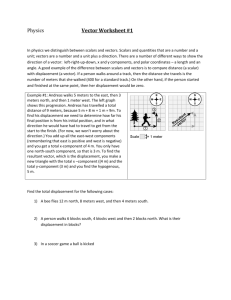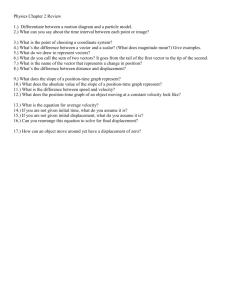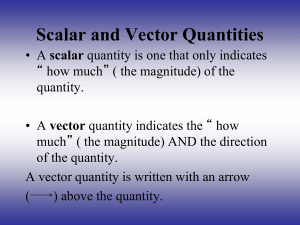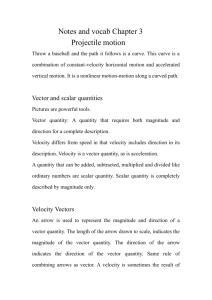1-Dimensional Motion
advertisement
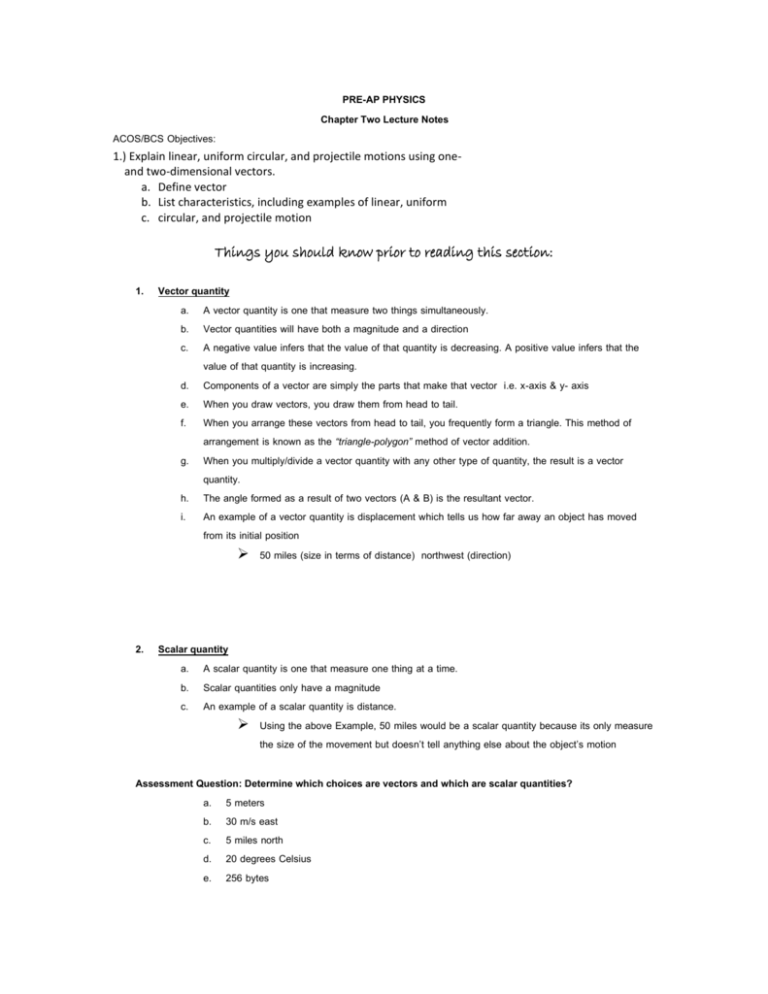
PRE-AP PHYSICS Chapter Two Lecture Notes ACOS/BCS Objectives: 1.) Explain linear, uniform circular, and projectile motions using oneand two-dimensional vectors. a. Define vector b. List characteristics, including examples of linear, uniform c. circular, and projectile motion Things you should know prior to reading this section: 1. Vector quantity a. A vector quantity is one that measure two things simultaneously. b. Vector quantities will have both a magnitude and a direction c. A negative value infers that the value of that quantity is decreasing. A positive value infers that the value of that quantity is increasing. d. Components of a vector are simply the parts that make that vector i.e. x-axis & y- axis e. When you draw vectors, you draw them from head to tail. f. When you arrange these vectors from head to tail, you frequently form a triangle. This method of arrangement is known as the “triangle-polygon” method of vector addition. g. When you multiply/divide a vector quantity with any other type of quantity, the result is a vector quantity. h. The angle formed as a result of two vectors (A & B) is the resultant vector. i. An example of a vector quantity is displacement which tells us how far away an object has moved from its initial position 50 miles (size in terms of distance) northwest (direction) 2. Scalar quantity a. A scalar quantity is one that measure one thing at a time. b. Scalar quantities only have a magnitude c. An example of a scalar quantity is distance. Using the above Example, 50 miles would be a scalar quantity because its only measure the size of the movement but doesn’t tell anything else about the object’s motion Assessment Question: Determine which choices are vectors and which are scalar quantities? a. 5 meters b. 30 m/s east c. 5 miles north d. 20 degrees Celsius e. 256 bytes f. 4,000 calories Section One Objectives: 1. Be able to describe motion in terms of frame of reference, displacement, distance and time I. Frame of reference – it is simply a comparison point used to describe motion. When you’re driving your car, without looking at your speed odometer, how do you gauge if you’re speeding or not? You look at how fast you’re passing objects externally such as other cars. Therefore the other cars or the stationary objects would serve as your frame of reference to measure speed. If I decide to leave the school and just start walking, if I didn’t have a walking odometer, how would I measure how far I’ve gone? I could simply turn around and simply visual look and see how far I am from the school. The school then would be my reference point. II. Distance - is a scalar quantities which refers to "how much ground an object has covered" during its motion. The SI Units for distance is meters. To test your understanding of distance, consider the motion depicted in the diagram below. A physics student moves in the following direction (from top to bottom) 1) 4 meters east 2) 2 meters south 3) 4 meters west 4) Finally 2 meters north. III. Displacement - is a vector quantity which refers to "how far out of place an object is"; it is the object's overall change in position. x = xf - xi (change in position = final position – initial position) Displacement can be either positive (right or up) or negative (left or down) Let’s say a student skier traveled the following course during a three minute interval. What is the student’s total displacement? 140 m East A. Student travels 180 meters east B. Student turns around and then travels 140 meters west C. Student turns around again and travels 100 meters east IV. time - it is a scalar quantity that is used to sequence events time is a numeral value only i.e you have never heard anyone say that the time was, “afternoon” The SI Units for time are seconds 2. Be able to construct and interpret graphs of position versus time. Figure A gives a pictorial view of the distance traveled over the 5 second interval. Figure A Figure B Figure B gives a graphical view of Figure A. The slope of the line in Figure B represents the average velocity of the object The y-axis represents Position in meters and the x-axis represents the time in seconds. Assessment Questions: 1. At t=3, how far had the car traveled? 2. How long did it take the car to travel 30 meters 3. How many meters are being traveled per second? 3. Be able to explain speed versus time I. Speed – a scalar quantity that measures the change in distance with respect to time; tells one how fast the body is moving but not the direction of the motion. Because speed changes frequently, physicists work in averages. Average speed = distance travelled/time of travel The best known example of this is the speed odometer which tells you the distance traveled (in kilometers) over a period of time (in hours). II. Velocity – the rate of change of position (distance and direction) In physics because velocity can change numerous times during a short period of time, it’s simpler for physicist to measure it in terms of an average. V avg = x /t = xf –xi/ tf-ti = vertical coordinates/ horizontal coordinates Average velocity = change in position/change in time = displacement/time interval A person could be moving backwards and forwards at an erratic speed; however if they end up at the same starting point then there velocity is zero. Velocity is used by video game programmers to help make our animated characters move across the screen in the x, y, or z coordinates. Instantaneous velocity simply refers to the velocity at a given moment in time. Terminal velocity simply refers to the point where velocity reached its peak or an end point Assessment Question: During a race on level ground, Audra runs with an average velocity of 6.02 m/s to the east. What is Audra’s displacement after 137s? Rearrange the above equation to solve for x = (V avg) x (t) Write down what was given to you: (V avg) = 6.02 m/s; (t) = 137 s; D = east Plug in your given values into your rearranged equation above x = (6.02 m/s) x (137s) = 824.74 meters east (noticed that seconds cancelled out) 4. Be able to explain projectile motion and be able to apply trigonometric functions to solve for unknown projectile variables. Projectiles are simply objects that are thrown or launched. The path that a projectile follows is in the shape of a parabola. A parabola resembles an upside down U To understand this path, throw a pen in the air and describe it’s path. If you notice that path that it took was either wide or condensed. But either way, it resembled a hill or an upside down U SOH-CAH-TOA is a mnemonic used to help remember the trig functions. These functions can be used to resolve projectile vectors into their components. 1. sinѲ = opposite/hypotenuse 2. cos Ѳ = adjacent/hypotenuse 3. tan Ѳ = oppsosite/adjacent
